If you’re looking for a cooling option that’s cheaper and more energy-efficient than air conditioning, ceiling fans may be the way to go. But what type of ceiling fan should you take for a spin? They may seem like a simple appliance however, there’s a massive range out there for you to choose from. Canstar Blue breaks down different ceiling fan features and models to help you make an informed decision.
What are ceiling fans?
Ceiling fans are, as you’d expect, fans that are installed to hang from your ceiling. These fans don’t actually make the air cooler. Instead, they move air around the room to produce a draft, creating a cooling effect. Ceiling fans are primarily designed to battle heat in the summer however, some models can be used in conjunction with heaters to keep your house warm in the winter.
Ceiling fans vs air conditioners
The toughest trade-off Australians have to make every summer is the balance between suffering the heat and suffering the cost of running the air conditioning. If it’s not too hot, a ceiling fan can be a welcome addition to a stuffy room where there isn’t enough natural airflow to keep things fresh. The best answer to the ceiling fan vs air conditioner question is probably to have both. That way, you can save your air con for only those unbearably hot summer days.
Read more: Ceiling fan running costs
AC vs DC ceiling fans
Ceiling fans run on either AC (Alternating Current) or DC (Direct Current) motors. Both types of motor are effective however, there are some functional differences between the two. AC ceiling fans are generally cheaper but are less energy-efficient. Alternatively, DC fans boast compact motors, allowing for slimmer deigns and more speed options, hence the heftier price tag.
Who sells ceiling fans?
Ceiling fans are a great way to beat the sweltering summer heat. Many brands offer ceiling fans in Australia including Mercator, Lucci Air, Hunter Pacific, Martec, Brilliant, Hunter and Arlec.
Mercator ceiling fans
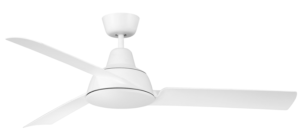
Mercator offer an extensive range of affordable ceiling fans for you to choose from. Most feature summer and winter settings, remote controls, quiet operation and quick-connect wiring.
The Mercator Airventure AC ceiling fan features three-speed wall control, an optional light fitting, reversible airflow for all seasons and ABS blades that function in both indoor and covered outdoor environments. This model will cost you around $220.
Lucci Air ceiling fans
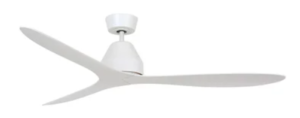
Lucci Air offer a variety of ceiling fans, with a keen focus on both energy-efficiency and style. Most Lucci Air fans host optional light fittings with dimming capability, multiple colour options and multi-speed remote controls.
The Lucci Air Whitehaven ceiling fan features an energy-efficient DC motor, a six-speed remote control, a timer function, natural wind mode and multiple colour options. The Whitehaven is equipped with ABS blades, which are perfect for indoor use. This model will set you back around $450.
Hunter Pacific ceiling fans
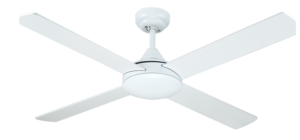
Hunter Pacific have been a long-time player in the ceiling fan game, with a wide range of both indoor and outdoor models. Most fans feature optional light fittings, slimline motors and can be controlled remotely or via a mounted dial.
The Hunter Pacific Azure AC ceiling fan is equipped with safe and quiet timber blades, three-speed wall control and an adaptable light fitting. This model is suitable for indoor use only and commonly retails for around $170.
Martec ceiling fans
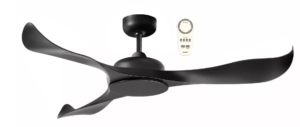
Martec offer ceiling fans in a range of styles and builds for you to choose from. Many Martec models are equipped with summer and winter modes, optional LED lighting and energy-efficient brushless motors.
Martec’s Scorpion ceiling fan hosts a quiet and efficient DC motor, ABS blades, multiple colour options and a five-speed remote control. This ceiling fan is designed to suit both indoor and covered outdoor settings and will set you back around $350.
Brilliant ceiling fans
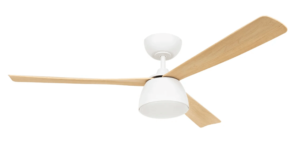
Brilliant ceiling fans are designed with energy-efficiency in mind. Most models feature adaptable light fittings, multi-speed remote controls, quick-connect wiring and fade resistant blades.
Brilliant’s Sofi ceiling fan hosts a six-speed remote control with summer and winter settings, a timer function, tri-colour LED lighting and ABS blades. This ceiling fan is best suited to both indoor and covered outdoor environments. The Sofi model commonly retails for around $200.
Hunter ceiling fans
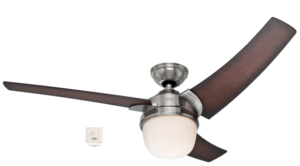
Hunter, not to be confused with Hunter Pacific, are known for their unique ceiling fan designs. Most fans feature uniquely shaped blades, reversible motors and angled mounting options.
The Hunter Eurus ceiling fan is equipped with an integrated lighting kit, three-speed wall control, summer and winter modes, beech veneer blades and an AC motor. This ceiling fan is designed for indoor use and generally costs around $450.
Arlec ceiling fans
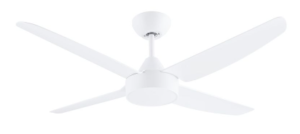
Arlec offer a relatively small range of ceiling fans that are popular for their affordability. Most Arlec fans feature multi-speed wall dials, summer and winter reverse functions and corrosion free blades.
The Arlec Chicago ceiling fan features three-speed wall control, a reversible AC motor, UV stabilised ABS fans blades to protect against corrosion and an optional light fitting. This fan is suitable for indoor use and can be purchased for around $110.
How much do ceiling fans cost?
The cost of a ceiling fan depends heavily on design, size, brand and other additional features. Some of the cheapest ceiling fans can be purchased for around $100, while more expensive models may cost upwards of $3,000.
Ceiling fan installation
A cost that can be easy to forget is installation. Ceiling fans aren’t an appliance you can just mount yourself if you’re not a qualified electrician, as it involves some significant electrical work. Installation fees can often exceed the cost of buying the actual fan, so bear that in mind if you’re on a tight budget. As with any renovation work, it’s worth calling around to find a competitive quote.
Is it worth buying a ceiling fan?
If you’re looking for a cheap and energy-efficient cooling solution, a ceiling fan may be the appliance for you. Alternatively, if you already have an air conditioner, ceiling fans are a great sidekick, circulating cool air in summer and warm air in winter. These fans also ensure peace of mind, as you won’t need to worry about a massive power bill after accidentally leaving them running all day long. However, if you’re after a more heavy-duty cooling tool, air conditioning may be the way to go. Check out some of Canstar Blue’s best-rated air conditioners to help you decide which appliance will suit your home best.
Air Conditioner Reviews & Ratings
Original Author: Tahnee-Jae Lopez-Vito




Share this article